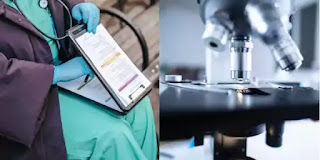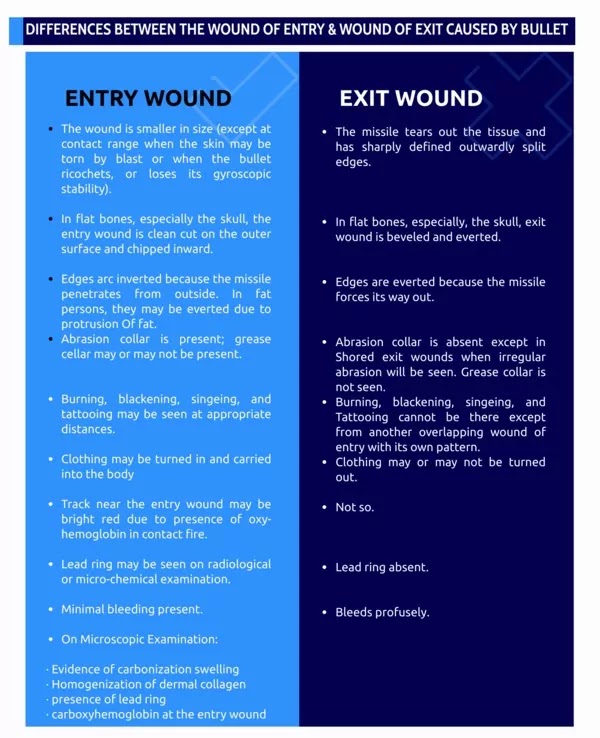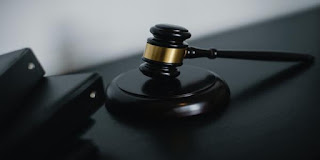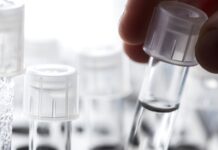Table of Contents
ToggleAdd Your Heading Text Here
A Fire arm is a specialized device designed to propel a projectile (shot/bullet/missile) by the expensive force of gasses generated as a result of combustion of the propellant (powder) at its base in a closed space. This combustion results in building up of optimum pressure which forces the missile out of the muzzle (mouth of a firearm) with sufficient velocity, resulting in the form of injury.
Other means:
Those fired from rifled weapons, such as rifle, revolver or pistol or bullets.
Those fired from smooth bored weapons like shot guns are lead (or recently steel) shots and pallets.
Other projectiles within medico-legal work are pallets and slugs in air guns, and metal scrap, nails, stones etc; in muzzle loading guns.
A bullet is made of lead which has higher sectional density (mass/diameter). So essential for a steady flight. Since Lead is a soft material and easily deformable, the bullet is jacketed either fully or partially with cuprnickle, copper or other harder casing. The tip of the bullet is known as nose. The bullet is cylindrical from the base onwards and conical towards the tip (nose).
*Wounding effects: that are the result of strike by the projectile (bullet or short-charged), flame, hot gases, wad and any other component of ammunition like broken pieces of bullet case.
*Non Wounding effects: which are caused by smoke, un-burnt powder and grease.
Firearm wound complex has four parts.
- · An entry wound.
- · A track with its direction.
- · Place of resting of bullet or shot charge.
- · Exit wound.
Entry wound are classified in relation to the distance of the muzzle of a firearm from the body. When a weapon is discharged, the projectile leaves the muzzle at its maximum velocity and is accompanied by a flame, hot gases under considerable pressure, soot, discharge of burnt & un-burnt particles and metallic particles. At close ranges, all these will cause injury to the body giving entry wound many special characteristics which the exit wound will lack. The appearance of the entry wound and its extent are also influenced by the type of weapon and its caliber, the nature of the projectile and powder used, the site of body hit, and the striking velocity as a result loss or velocity Of the projectile before hitting the body.
Guidelines of Surgeon Medico-legal Punjab, Pakistan 2021
| Effects produced by | Range | Physical finding observed |
| Wound of entry | effective range | Lacerated, circular, penetrating wound. |
| Hot Gases | 01 – 03 inches | Splitting, Crepitus, CO effect |
| Flame | 01 – 03 inches | Scorching, Singing of hair |
| Smoke | 06 – 12 inches | Smudging |
| Powder particles | 12-36 inches | Tattooing |
| Metal particles | up to 36 inches | Metallic dust around entry wound |
| Cards & wad | up to 36 inches | Abrasion, contusion & laceration |
This is free from sign of burning, blackening or tattooing, and usual collars of entrance wound. It will show an atypical abrasion when the skin is supported at the exit by a belt, tight clothing, or wall (shored exit wound). A typical abrasion is irregular at the edges, lop sided, and too large as compared to the abrasion collar of an entry wound. The fibers of the clothes may or may not be turned out. An uncomplicated exit wound is usually split from within outward.
In 2020 there were 50,000 deaths in the USA because of firearms. 60% of them were suicides, and 37% were homicides. These figures do not include non-fatal injuries that usually leave permanent physical injuries or post-traumatic stress. All these involve delicate medicolegal problems.
Determination of Cause
Unfortunately, recording in the frenetic emergency rooms is not giving enough information to get a handle on changing these figures. Medicolegal aspects of these wounds are important in determining the cause of the wounds. Postmortem details are sometimes difficult to determine and must be on the death certificate for the family, insurance, and legal or police work.
Today it is important to determine whether the wounds were self-inflicted on purpose or accidentally if the injuries might be homicide or they were accidental.
Modern medicolegal systems use tools and equipment to analyze, finding results more inexpensively and with more accuracy. The postmortem computer tomography is used with firearm wounds to follow bullet trails and to recognize bullet fragments. This powerful machine helps to determine what happened in the case of ‘tandem bullets’, that is two bullets released with one pull of the trigger. Because the bullets often go in different directions, this can be confusing to the trained eye.
The Problem of Interpreting
There are many reasons why a firearm wound might be misinterpreted postmortem:
- The firearm may have been badly put together,
- The bullet might not be right for the firearm used,
- Another target might interfere and get in the way,
- Or the bullet might ricochet.
- A silencer may have been misaligned
- The bullet might be deformed
Any of these might result in a strange wound that medicolegal personnel can’t interpret. That is when the Postmortem Computed Tomography machine can be handy at helping interpret the cases.
RELATIONSHIP BETWEEN ENTRY AND EXIT WOUND:
The Wound edges may be inverted at the entry and everted at the exit. The abrasion ring will help to distinguish entry from exit. In case of difficulty, microscopic examination and X-Ray examination of the skin or clothing may be undertaken. Evidence of carbonization swelling, homogenization of dermal collagen, presence of lead ring if any, and carboxyhemoglobin at the entry wound will distinguish it from the exit wound.
Qiyas & Diyat Ordinance (Simplified Form)
DIFFERENCES BETWEEN THE WOUND OF ENTRY AND WOUND OF EXIT CAUSED BY BULLET
IMPORTANT POINTS REGARDING MLC
Patient is mostly serious if bullet hits chest or abdomen / head / neck; you don’t have time to wait and keep the victim; In that case:
1. Vitally stable the victim, don’t stitch or remove the bullets, only apply pressure bandage.
2. Write 2 marks of identification by yourself, you should see with your eyes (it’s important).
3. Color of clothes and note down number / size of holes u see at entry and exit sites. Roughly write at some paper what you think bullets correspond to respective holes in the clothing’s. Note any soot / blacking / burning at cloth fibers at site of entry of bullet. You write it all as your record to further copy it on MLC page.
4. Now examine the wounds,
- o Make a drawing on rough paper, this drawing you will draw on the MLC paper later on. 1stly you make sure it’s a bullet or not /superficial / deep / single entry wound, blacking / sooting / hair burn.
- o Is there exit? Make trajectory of path and if you don’t see any exit write no exit but there can be swelling redness on opposite side which you will mention.
5. If there are multiple bullets fired, see through-through, does two superficial entry-exit point has a connection? Do it with a pencil or scissor but do not open any closed wound, also note and scratch the clotted blood at wounds, sometimes they are just scratches and no bullets with no depths. Don’t listen to attendants they will force you to believe it’s a firearm.
6. You keep the docket of police in MLC register which you will fill after patient is referred to tertiary care hospital, or some other government hospital in another city but On your emergency slip you will write MLC NUMBER / identity marks/ clothing’s which will be saved in that hospital.
7. After all of this, you refer victim and advised x ray / CT / ultrasound on slip.
8. Make 2 separate slips; write please give expert surgical and radiological opinion with procedural / operational Notes or findings.
You send the patient, keep an attendant with you to fill in the MLC register, you write all you wrote on rough paper.
You hand over the MLC / docket to police. Your work is done.
9. For rare cases where you suspect it’s fabricated or not a firearm wound or where you want to linger on bad attendants….. Foran insaaf ki farahmi na krain, take clothing of patient and scrap the area / swabs or take pieces of shrapnel, seal them and send them to firearm and ballistics PFSA Lahore for kind of weapon and does the Gun powder matches on cloth and scraps. It will take a month for report to come back to you.
#Result # after some days patient will come back for result. They will force you to declare it as firearm without tertiary care hospital notes, don’t do it ,if you declare it ,opponent party will challenge it as you will not have any proof of what happened in tertiary care hospital. Have an emergency slip and ask the tertiary hospitals 1=radiologist 2= surgery for operational / surgical / procedural notes.
And do write ATTESTED COPIES of everything, MS / AMS / Professor / AP can attest the procedural files.
Without it they are useless in court and you cannot declare result unless you have them as proof. Radiological report of fracture / bones / ribs etc. Surgical notes / visceral damage or not / depth of wounds.
*You will write USG/x ray/CT/ surgical notes for viscera / intubation / haemothorax in detail on MLC paper. After all this, you will write from all investigations and surgical and radiological opinions [it is likely a firearm injury]. There are special sections of firearm that only police puts.
Sometimes fake firearm cases come, people forces you to declare small cuts / abrasions / minor wounds as firearm. Your job is to access the clothing / wounds / history and then declare it as firearm or not. If you think it’s not firearm, declare it as blunt or sharp weapon.
Remember, blackening, soot, burning may not be present ,entry and exit wounds can be mixed as ‘Fankaar Qoum’ so that doctor can be dodged When you don’t see signs of close contact you write distance may be more than 3 feet, in this way self inflicted fires get away. So you write its firearm injury and subject it to I.O (investigating officer) to further investigate.








